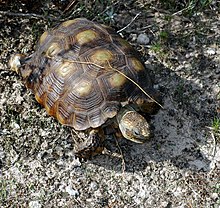Texas tortoise
| Texas tortoise | |
|---|---|

| |
| Scientific classification | |
| Domain: | Eukaryota |
| Kingdom: | Animalia |
| Phylum: | Chordata |
| Class: | Reptilia |
| Order: | Testudines |
| Suborder: | Cryptodira |
| Superfamily: | Testudinoidea |
| Family: | Testudinidae |
| Genus: | Gopherus |
| Species: | G. berlandieri
|
| Binomial name | |
| Gopherus berlandieri (Agassiz, 1857)
| |
| Synonyms[3] | |
| |
The Texas tortoise (Gopherus berlandieri) is a species of tortoise in the
that are native to North America.Geographic range
G. berlandieri is found from southern Texas southward into the Mexican states of Coahuila, Nuevo León, and Tamaulipas.
Etymology
The
Biology
The Texas tortoise, unlike other species of gopher tortoise, is not an adept burrower. Its preferred habitat is dry scrub and
Conservation status
Though considered an animal of low concern by the IUCN Red List, the Texas tortoise is listed as a threatened species in the state of Texas, and thus protected by state law. It is illegal to collect or possess them. The Mexican federal government lists Gopherus berlandieri as A (= Threatened) in Mexico.[6] Likewise, using Environmental Vulnerability Scores, Gopherus berlandieri scored 18, a high vulnerability species on a scale of 0–20, in evaluations of both Tamaulipas and Nuevo Leon herpetofauna.[7][8] In 2018, the IUCN Tortoise and Freshwater Turtle Specialist Group recommended a re-assessment and re-classification of all six Gopherus species.[9] This reclassification would move G. berlandieri from Near Endangered (NE) to Near Threatened (NT).[9]
Gallery
-
Texas tortoise (Gopherus berlandieri), Val Verde Co, Texas, USA (2005).
-
Gopherus berlandieri, Bee Co. Texas, USA (June 2011).
-
Gopherus berlandieri, Bee Co. Texas, USA (2011).
-
Elongated gular scutes of male, Bee Co. Texas, USA (2011).
-
Texas tortoise (Gopherus berlandieri), northern Tamaulipas, Mexico (2007).
-
Texas tortoise (Gopherus berlandieri), Bee Co. Texas, USA (2023).
- . Retrieved 9 May 2023.
- ^ "Appendices". CITES. Convention on International Trade in Endangered Species of Wild Fauna and Flora. 4 May 2023. Retrieved 9 May 2023.. Note: Protected as a member of the Testudinidae.
- ISSN 1864-5755.
- ^ ISBN 978-1-4214-0135-5. ("Berlandier's Tortoise Gopherus berlandieri ", p. 24).
- ^ Bour, Roger (2016). "Where and when was Jean Louis Berlandier born? Notes on Jean Louis Berlandier. I.". Bibliotheca Herpetologica 12 (1 & 2): 18–40.
- ^ Official Mexican STANDARD NOM-059-SEMARNAT-2010, Environmental Protection-Native species of Mexico of wild flora and fauna-Risk categories and specifications for inclusion, exclusion or change-List of species at risk. STANDARD NOM-059-SEMARNAT-2010 PDF
- ^ Terán-Juárez, S. A., E. García-Padilla, V. Mata-Silva, J. D. Johnson, and L. D. Wilson (2016). "The herpetofauna of Tamaulipas, Mexico: composition, distribution, and conservation". Mesoamerican Herpetology 3: 43–113.
- ^ Nevárez-de los Reyes, M., D. Lazcano, E. García-Padilla, V. Mata-Silva, J. D. Johnson, and L. D. Wilson (2016). "The herpetofauna of Nuevo León, Mexico: composition, distribution, and conservation". Mesoamerican Herpetology 3: 558–638.
- ^ S2CID 91937716.
References
External links
- Tortoise & Freshwater Turtle Specialist Group (1996). "Gopherus berlandieri ". . Retrieved 9 January 2018.
- Species Gopherus berlandieri at The Reptile Database







